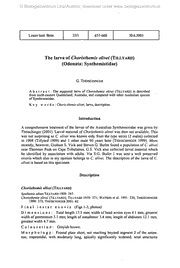Table Of Content© Biologiezentrum Linz/Austria; download unter www.biologiezentrum.at
Linzer biol. Beitr. 35/1 . 657-660 30.6.2003
The larva of Choristhemis olivei (TILLYARD)
(Odonata: Synthemistidae)
G. THEISCHINGER
Abstract: The supposed larva of Choristhemis olivei (TILLYARD) is described
from north-eastern Queensland, Australia, and compared with other Australian species
of Synthemistidae.
Key words: Choris themis olivei, larva, description.
Introduction
A comprehensive treatment of the larvae of the Australian Synthemistidae was given by
Theischinger (2001). Larval material of Choristhemis olivei was then not available. This
was not surprising as C. olivei was known only from the type series (2 males) collected
in 1908 (Tillyard 1909) and 1 other male 90 years later (THEISCHINGER 1999). More
recently, however, Graham S. Vick and Steven G. Butler found a population of C. olivei
near Thornton Peak on Cape Tribulation. G.S. Vick also collected larval material which
he identified by association with adults. Via S.G. Butler I was sent a well preserved
exuvia which also in my opinion belongs to C. olivei. The description of the larva of C.
olivei is based on this specimen.
Description
Choristhemis olivei (TILLYARD)
Synthemis olivei TILLYARD 1909: 747.
Choristhemis olivei (TILLYARD); TILLYARD 1910: 371; WATSON et al. 1991: 230; THEISCHINGER
1999: 373; THEISCHINGER 2001: 42.
Final instar exuvia (Figs 1-3, photos)
Dimensions: Total length 17.5 mm; width of head across eyes 4.1 mm; greatest
width of prementum 3.1 mm; length of metafemur 3.4 mm; length of abdomen 12.1 mm,
greatest width 4.7 mm.
Colouration: Greyish brown.
Morphology: Frontal plate short, not reaching beyond segment 2 of the anten-
nae, trapezoidal, with moderatly long, apically significantly widened, setal structures
© Biologiezentrum Linz/Austria; download unter www.biologiezentrum.at
658
along margins. Prementum widened rather abruptly from narrow base; 6 pairs of primary
and 8-9 pairs of secondary setae; ligula with very prominent but rather narrow median
lobe (Fig. 1); labial palps with 6/7 dentations (Fig. 2); 6 palpal setae; postmentum narrow
and with distinct median notch. Fringe along posterior eye margin consisting of scale-
like setal structures and rather prominent. Postocular lobe rounded, its margin with short,
distally strongly widened, fan-like setal structures (Fig. 3). Pronotal lobes with long,
prominent setae. Abdominal terga without any processes, hairy
Material examined:! final instar exuvia, Australia, Queensland, Cape Tribulation, nr
Thornton Peak, Deep Forest Lodge, on seepage, near road (16°1 l'08"S/145°24'46"E), 25.12.1998,
G.S. Vick (GTAD = Günther Theischinger Collection).
Discussion
The larva of Choristhemis olivei - as described in this paper - can be distinguished from
all other synthemistid larvae by the combination of characters given in the description
above. It appears that it can be separated from the possibly sympatric (WATSON et al.
1991) Choristhemis flavoterminata (MARTIN) particularly by smaller size, a more promi-
nent median lobe of the prementum, a smaller number of palpal dentations and fan-like
setal structures on the postocular lobe.
Acknowledgements
For giving me the opportunity to describe the larva of Choristhemis olivei (TlLLYARD) I wish to
thank Graham S. Vick (Crossfields, Little London, Tadley, Hants, United Kingdom) and Steven G.
Butler (Red Willow, All Stretton, Shropshire, United Kingdom).
Zusammenfassung
Die Larve von Choristhemis olivei (TlLLYARD) (determiniert per exclusionem) von Nordost-
Queensland, Australien, wird beschrieben. Sie kann von den bekannten Larven aller anderen
australischen Synthemistiden durch die in der Beschreibung gegebene Mermalskombination unter-
schieden werden. Von der potentiell sympatrischen Choristhemis flavoterminata (MARTIN) unter-
scheiden sie wohl vor allem geringere Grosse, ein stärker ausgeprägter Mittellappen des Premen-
tum, weniger Palpenzähne und fächerförmige Borsten in der Postocularregion.
References
THEISCHINGER G. (1999): New and little-known Synthemistidae from Australia (Insecta:
Odonata). — Linzer biol. Beitr. 31: 373-379.
THEISCHINGER G. (2001): Preliminary keys for the identification of larvae of the Australian
Synthemistidae, Gomphomacromiidae, Pseudocorduliidae, Macromiidae and
Austrocorduliidae (Odonata). — Cooperative Research Centre for Freshwater Ecology,
Thurgoona (NSW) pp. i-iv, 1-88.
TILLYARD R.J. (1909). On some remarkable Australian Corduliinae, with descriptions of new
species. — Proc. Linn. Soc. N.S.W. 33: 737-751.
© Biologiezentrum Linz/Austria; download unter www.biologiezentrum.at
659
TILLYARD R.J. (1910). Monograph of the genus Synthemis (Neuroptera: Odonata). — Proc.
Linn. Soc. N.S.W. 35: 312-377.
WATSON J.A.L., THEISCHINGER G. & H.M. ABBEY (1991): The Australian Dragonflies. A
guide to the identification, distributions and habitats of Australian Odonata. — CSIRO:
Canberra and Melbourne.
Address of the author: Günther THEISCHINGER
2A Hammersley Road
Grays Point, N.S.W., Australia 2232
© Biologiezentrum Linz/Austria; download unter www.biologiezentrum.at
660
Figs 1-3. Choristhemis olivei (TILLYARD), final instar exuvia: (1) median lobe of premental ligula,
ventral aspect; (2) distal margins of labial palps, frontal aspect; (3) fan-like setae on postocular
lobe, dorsal aspect.
Photos: Choristhemis olivei (TiLLYARD), final instar exuvia: (left) dorsal; (right) ventral.

